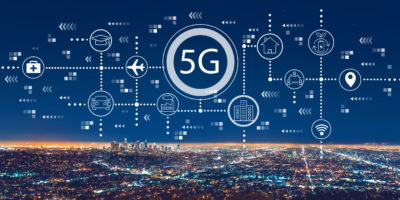The coronavirus pandemic has slowed and, in many cases, halted business operations across the U.S. and the world. As employees and students across the globe carried on their work and education from home, the strain on wireless networks has highlighted the need for digital sustainability through 5G infrastructure transition.
But, has the pandemic also knocked U.S. carriers off their axis of deploying 5G networks? A recent report by Yahoo Finance provides a glimpse into the state of 5G deployment amid local government office closures and remote working procedures.
AT&T’s 5G network is now available in 190 markets across the United States and 5G+ services are offered in 35 cities across its mmWave network.
AT&T plans to deploy a standards-based nationwide mobile 5G network in 2020, providing a seamless transition among WiFi, LTE and 5G services. Yahoo noted the company aims to roll out dynamic spectrum sharing in the second half of 2020 to enable the deployment of 4G and 5G in the same band and allocate spectrum resources between them. AT&T appears to be on track towards enhancements in coverage, speeds, and devices.
Verizon’s 5G Ultra-wideband mobility service is now available in 35 cities. The carriers’ fundamental drivers include massive spectrum holdings, particularly in the millimeter wave bands for faster data transfer, end-to-end deep fiber resources and the ability to deploy large numbers of small cells.
Aiming to retain its leading position in transmitting 5G mobile networks nationwide, Verizon created a virtual lab as a workaround to social distancing standards. The virtual machines provide advanced levels of operational automation and adaptability critical to accelerating its 5G network. Verizon also intends to work with leading technology partners to advance the 5G ecosystem and bring unparalleled experiences to customers, Yahoo reported.
Lastly, T-Mobile boasts 5G service in 50 states and recently partnered with General Communication Inc. to bring 5G network connectivity to Anchorage, Alaska. With its recent merger with Sprint, the New T-Mobile combines high- and low-band spectrum for faster nationwide 5G rollout.
The New T-Mobile anticipates 14 times more capacity in the next six years than on a standalone basis, which the carrier claims will enable it to leapfrog the competition in network capability and experience, according to Yahoo. Customers can expect access to average 5G speed, which will be “up to eight times faster than current LTE in a few years and 15 times faster over the next six years.” T-Mobile’s aggressive 5G deployment plans expect to provide 5G to 99 percent of the U.S. population and average 5G speeds above 100 Mbps to 90 percent of the population within six years.





Reader Interactions